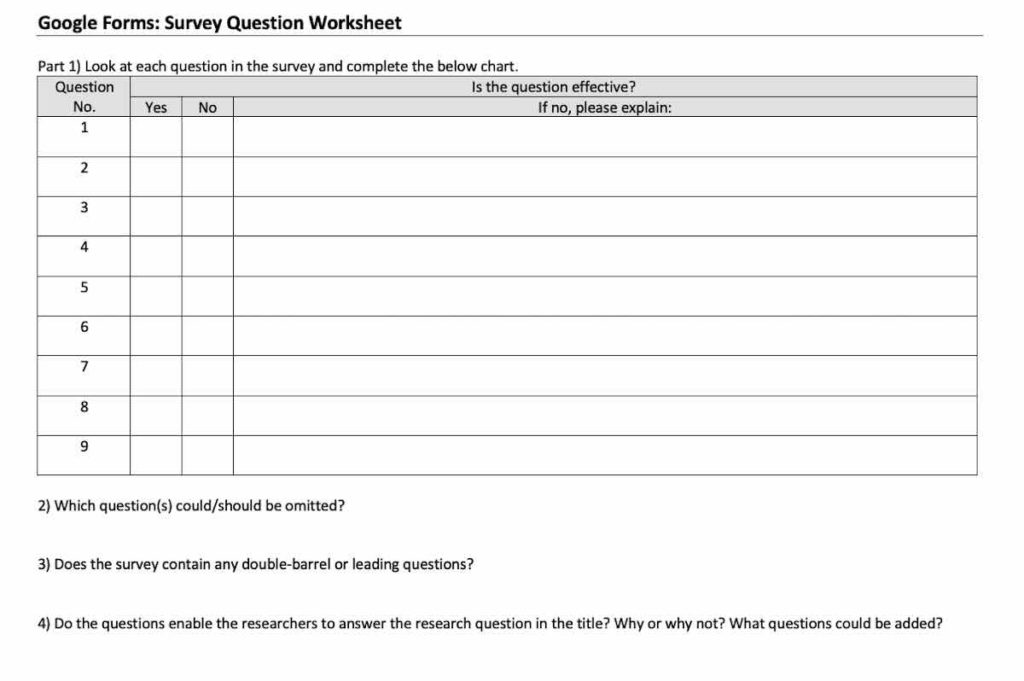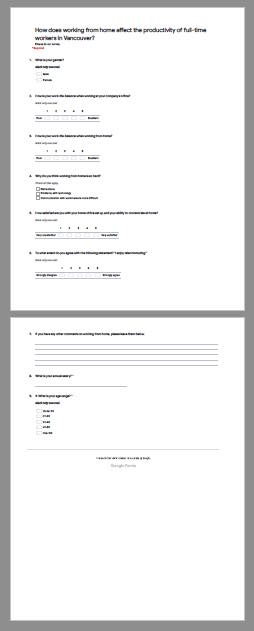English Level: college & university, EAP
Skill Focus: identifying flaws in a survey
Class Time Required: approximately 40 minutes
Material Downloads: survey-questions-worksheet.docx, working-from-home-survey.pdf
Foreword
If you are teaching a class that requires students to conduct a survey, this worksheetd could be useful. I use it with my undergraduate students to teach them to identify poor survey design. You could do this activity before teaching them survey fundamentals or do it afterward to reinforce these ideas, as I do.
Here are the materials that I use for teaching how to design proper surveys (I only have about 45 minutes of class time to do this):
- Introduction to Survey Design and Delivery (PDF link): I do a jigsaw group reading activity with the 'Constructing Survey Questionnaires' section from pages 7 to 11.
- Seven Tips for Good Surveys (Youtube link): a short four-minute video.
Google Forms Survey Worksheet
The survey below was designed with Google Forms, which I use instead of SurveyMonkey because users can create more than 10 questions (limited on SurveyMonkey) and it is free and easy to use.
The research question is "How does working from home affect the productivity of full-time workers in Vancouver?" If you find the survey doesn't suit your needs, you could easily create your own survey on Google Forms.
Google Forms Survey Preview
(Click on the image for full PDF or download it above.)
Survey Worksheet Preview
(Download link at top of page). The worksheet is in Microsoft Word format so students can edit it.

Possible Answers for Problems with Survey
- Instead of “Please do our survey”, the survey should explain who is doing the survey, what the purpose of the survey is, how the information will be treated (confidentiality), and finally thank the respondent for participating.
- Q1: There should be an `other' or `prefer not to say' option here.
- Q4: Two problems: a) this is a leading question that suggests working from home is hard, and b) the options are limiting; perhaps add an `other: ___ option so respondents can add their own factors.
- Q5: This is a double-barreled question. There are two topics (home office set up AND concentration at home) in the question, which makes it confusing to answer.
- Q6: The term `telecommuting' needs to be parsed (explained) or avoided as the respondents may not know what it means.
- Q8: Question is too personal and not needed. Also, it should not be mandatory.
Other comments:
- All demographic questions (e.g. Q1) should be together, probably at the end)
- The main problem is that these questions don't allow the researchers to answer the research question, which is about productivity. For instance, the survey asks about work-life-balance but not productivity specifically. Better questions are needed to focus on how effective workers are at home compared to the office.
---
I hope you find this useful for your class on surveying and research skills.
-- Matthew Barton / Creator of Englishcurrent.com

